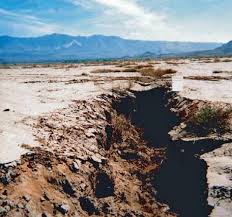Land Subsidence:

Uttarakhand, already battered by natural calamities including cloudbursts, flash floods, and landslides across its mountainous regions, is now facing a new and terrifying phenomenon: widespread land subsidence in Chamoli’s Nanda Nagar.
- Land subsidence is a gradual settling or sudden sinking of the Earth’s surface.
- This geotechnical phenomenon occurs when the ground loses its ability to support the weight above it, leading to a downward shift.\
- It can occur as a result of natural factors (e.g., volcanic or seismic activity, collapse of subsurface cavities, compaction of loose fine-grained deposits) or anthropogenic activities (e.g., excessive groundwater (GW) abstraction, mining, subsurface energy extraction).
- Although it is a gradual process, taking years to decades to develop, land subsidence presents serious socioeconomic, environmental, and security challenges globally.
- Land subsidence can cause damage to infrastructure and lead to increased flood risks and permanent reduction in aquifers’ storage capacity.
- It can also cause disturbance to water management and possible repercussions such as increased saltwater intrusion as a result of reduction in land elevation and changes in the gradient of streams and drains.
- High maintenance costs for roads, railways, pipelines, and buildings are only a few examples of stresses brought upon by land subsidence.
- Although land subsidence has been historically observed in low deltaic areas or coastal regions, it is being increasingly observed in large inland areas near densely urban, agricultural, and industrial areas with high groundwater demand.
- Excess groundwater extraction is believed to be one of the main causes of large-scale and high-magnitude land subsidence.
- Groundwater overexploitation compacts the underground reservoirs because water is the element partly responsible for holding up the ground.
- The excess water withdrawal leads to compaction of the underlying depleted porous formation, thus inducing land subsidence.
- The total global extent of land surface susceptible to subsidence has been estimated to be 12 million sq.km.
- Land subsidence has been observed all around the world, with major sites in the USA, China, Iran, Indonesia, Taiwan, Vietnam, Egypt, Japan, Mexico, and Italy.




